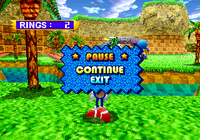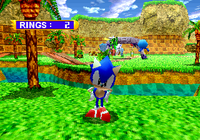Difference between revisions of "Clean pause"
From Sega Retro
(→Saturn) |
(→Saturn) |
||
| Line 63: | Line 63: | ||
*''[[Fighting Vipers]]'' | *''[[Fighting Vipers]]'' | ||
*''[[Final Fight Revenge]]'' | *''[[Final Fight Revenge]]'' | ||
| + | *''[[Galaxy Fight]]'' | ||
*''[[Groove On Fight: Gouketsuji Ichizoku 3]]'' | *''[[Groove On Fight: Gouketsuji Ichizoku 3]]'' | ||
*''[[GT24]]'' | *''[[GT24]]'' | ||
Latest revision as of 05:31, 30 October 2024
Clean pause is the act of removing any special text or imagery that appears when a video game is paused. It is a feature used both as a debugging tool, and a means for the video game press to take accurate screenshots of a game in motion, without the game actually moving.
Contents
History
In the early days of video gaming, all "pauses" were "clean". Any implemented pause feature would literally "pause" the game from processing, the effect being a static image left on the television or computer screen until the game was unpaused. As technology progressed, developers began implementing indicators so that the user would know the game was paused so users knew what the state of the game was. With a limited number of buttons on a typical video game controller, pause screens were also been used to relay information to the player, change options and end the game.
However, the need for an "unchanged" pause screen was always a desire of both the video game press and marketing teams, which required the screen to be controlled and static in order to take aesthetically pleasing screenshots. With the only alternative to offer development builds and test hardware, many developers implemented a clean pause function to assist with these use cases. This feature often shipped with final, commercially released products, but was not typically mentioned in game manuals.
"Clean pause" is a colloquial name for this function, having been widely circulated in video game magazines and the internet since the 1990s. It was not given an official term by publishers such as Sega.
Implementations
Pre-Sega Saturn
Sega seemingly had fewer guidelines in regards to pause screens up until the release of the Sega Saturn, thus older games often always had clean pauses, negating the need for a code.
As pause screens became more complex, several developers implemented clean pause functions, but the codes were not standardised, usually being unique to a specific game (if implemented at all). Only a small handful of games are known to have shipped with clean pause codes; the result is that many video game magazines were forced to use screenshots with "PAUSED" text clearly visible.
Sega Saturn
The Sega Saturn library has patchy support for the clean pause function, which was usually standardised as ![]() +
+![]() +
+![]() (when paused). Performing the code again usually (but not always) reverts back to the standard pause screen.
(when paused). Performing the code again usually (but not always) reverts back to the standard pause screen.
Games published by Sega are more likely to implement this feature, the first major example likely being Panzer Dragoon, released in March 1995. It did not become standard practise until 1997, at which point a select pool of Japanese third-party developers also began implementing the feature, however support is patchy, likely because it was not mentioned in earlier software development guidelines and was never enforced.
Sega Dreamcast
For Dreamcast games, Sega mandated that when paused, the game should show the text "PAUSED" (or something similar to that effect) to distinguish pausing from software bugs[1]. As such, no Dreamcast games should default to a clean pause.
A clean pause feature, enabled by pressing ![]() +
+![]() (when paused) was "recommended" by Sega[2] but not mandated, meaning while a significant number of games implement a clean pause feature, not all do. Similarly to the Saturn, pressing the code usually (but not always) reverts back to the standard pause screen.
(when paused) was "recommended" by Sega[2] but not mandated, meaning while a significant number of games implement a clean pause feature, not all do. Similarly to the Saturn, pressing the code usually (but not always) reverts back to the standard pause screen.
Dreamcast pause screens have other limitations, with Sega demanding that images over a certain brightness threshold should not be displayed on-screen for more than five minutes (games having to implement "screensavers" to help prevent televisions from becoming damaged[1]). The guidelines are not specific as to what should happen if a clean pause is in effect; whether the screensaver feature should override the clean pause, or be disabled in this mode.
Uses via codes in games
Mega Drive
Mega-CD
Saturn
- Astra Superstars
- Battle Arena Toshinden URA
- Bust-A-Move 3
- Christmas NiGHTS into Dreams
- Choro Q Park
- Daytona USA: Championship Circuit Edition
- Daytona USA Circuit Edition
- Decathlete
- Die Hard Arcade
- Earthworm Jim 2
- F1 Challenge
- Fighter's History Dynamite
- Fighters Megamix
- Fighting Vipers
- Final Fight Revenge
- Galaxy Fight
- Groove On Fight: Gouketsuji Ichizoku 3
- GT24
- Guardian Heroes
- Hang-On GP
- Manx TT Super Bike
- Night Warriors: Darkstalkers' Revenge
- NiGHTS into Dreams
- Ninja Jajamaru-kun: Onigiri Ninpouchou Gold
- Panzer Dragoon
- Pu-Li-Ru-La/Arcade Gears
- Rabbit
- Radiant Silvergun
- Rayman
- Saturn Bomberman
- Sega Ages Phantasy Star Collection
- Sega Rally Championship
- Sega Rally Championship Plus
- Sega Rally Championship Plus NetLink Edition
- Sega Touring Car Championship
- Sonic Jam
- Sonic R
- Steep Slope Sliders
- Touryuu Densetsu Elan Doree
- Twinkle Star Sprites
- Virtua Cop
- Virtua Cop 2
- Virtua Fighter 2
- Winter Heat
Dreamcast
- 18 Wheeler: American Pro Trucker
- 4 Wheel Thunder
- AeroWings 2: Airstrike
- Alien Front Online
- Army Men: Sarge's Heroes
- Bangai-O
- Buggy Heat
- Bust-A-Move 4
- ChuChu Rocket!
- Conflict Zone
- Cosmic Smash
- Daytona USA 2001
- Disney/Pixar's Buzz Lightyear of Star Command
- Ecco the Dolphin: Defender of the Future
- Expendable
- F355 Challenge
- Giga Wing
- Hydro Thunder
- Ikaruga
- Incoming
- The King of Fighters: Dream Match 1999
- Le Mans 24 Hours
- Looney Tunes: Space Race
- MagForce Racing
- Mat Hoffman's Pro BMX
- MDK 2
- Nightmare Creatures II
- Ooga Booga
- Pen Pen TriIceLon
- Ready 2 Rumble Boxing
- Ready 2 Rumble Boxing Round 2
- Re-Volt
- Seventh Cross Evolution
- Sonic Adventure
- Sonic Adventure 2
- Soukou no Kihei: Space Griffon
- Speed Devils
- Street Fighter III: Double Impact
- Super Magnetic Neo
- Sword of the Berserk: Guts' Rage
- Tech Romancer
- Tokyo Xtreme Racer 2
- Toy Commander
- TrickStyle
- Vanishing Point
- Virtua Striker 2 Ver. 2000.1
- Wacky Races
- Zero Gunner 2
Other
Partial implementations
Some games do not fully implement the clean pause as likely intended, making the feature less useful. As the clean pause was never mandated and does not typically affect gameplay, it was likely not tested thoroughly by Sega's QA teams.
Saturn
- Panzer Dragoon Zwei (HUD elements still animate)
Dreamcast
- Sega Swirl (hides the playfield)
- Virtua Fighter 3tb (screen is still dark)
- Wild Metal (hides radar as well)

